Bengal cat
| Bengal Cat | |
|---|---|
 Bengal cat | |
| Origin | India |
| Foundation bloodstock | Egyptian Mau, Abyssinian, and others (domestic); Asian leopard cat (wild) |
| Breed standards | |
| FIFe | standard |
| TICA | standard |
| AACE | standard |
| ACF | standard |
| ACFA/CAA | standard |
| GCCF | standard |
| Feline hybrid (Felis catus × Prionailurus bengalensis bengalensis) | |
.jpg)
The Bengal is a domestic cat breed developed to look like exotic wild cats such as leopards, ocelots, margays and clouded leopards. Bengal cats were developed by selective breeding from hybrids of the Asian leopard cat, Prionailurus bengalensis bengalensis, with domestic cat, backcrossed to domestic cats, with the goal of creating a confident, healthy, and friendly cat with a highly contrasted and vividly marked coat.[1][2]
The name "Bengal cat" was derived from the taxonomic name of the Asian leopard cat (P. b. bengalensis). They have a "wild" appearance with large spots/rosettes/arrowheads, and a light/white belly, and a body structure reminiscent of the Asian leopard cat.[3] Bengals are an intelligent and active breed, and are known for being especially vocal and friendly.[4] Once separated by at least four generations from the original Asian leopard cat – domestic cat crossing, the breed's temperament resembles that of a domestic cat.[3]
Bengal cats are generally a bright orange to light brown colour, although pale or off-white "snow" Bengals also exist, and are popular among owners.[5]
History
Early history
The earliest mention of an Asian leopard cat × domestic cross was in 1889, when Harrison Weir wrote of them in Our Cats and All About Them.[6]
However, in 1927, C. Boden Kloss wrote to the magazine Cat Gossip[7] regarding hybrids between wild and domestic cats in Malaya: "I have never heard of hybrids between bengalensis (the Leopard Cat) and domestic cats. One of the wild tribes of the Malay Peninsula has domesticated cats, and I have seen the woman suckling bengalensis kittens, but I do not know whether the litter survived and bred with the others".[8]
The earliest mention of a confirmed Asian leopard cat to domestic cross was in 1934, in a Belgian scientific journal., and in 1941, a Japanese cat publication printed an article about one that was kept as a pet.[9] Jean Mill (née Sugden), the person who was later a great influence on the development of the modern Bengal breed, submitted a term paper for her genetics class at University of California, Davis on the subject of crossbreeding cats in 1946.[8]
Bengals as a breed
In the 1970s, Willard Centerwall[10] bred Asian leopard cats with domestic cats to aid his studies in genetics because of their apparent immunity to feline leukemia. Eventually, these hybrids were given to Jean Sudgen Mill because of Centerwall's illness.
At the same time, Bill Engler wanted to preserve the exotic cats' genes by breeding them with house cats. Although none of today's Bengal lines originate from these cats, he chose the name "Bengal", which was accepted by the American Cat Fanciers Association, the first registry to accept the breed.
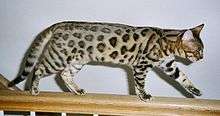
Jean Mill was instrumental in recognition of Bengals as a breed by The International Cat Association in 1983. Her plan was not to keep the breed as a hybrid, but to domesticate these cats by breeding them further with each other.[11] There were others, such as Doctors Greg and Elizabeth Kent, who were crossing their Egyptian Maus to their Asian Leopard cat Baghara Khan. While many breeders worked together to get the breed off the ground, it was Jean Mill who worked to get them accepted as a registered breed through The International Cat Association and began to show them around the world.
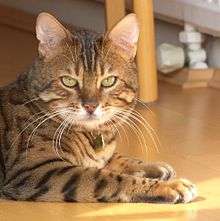

Legal developments
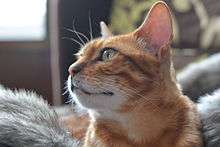
The UK Department for Environment, Food and Rural Affairs, Department for Environment, Food and Rural Affairs, removed the previous licensing requirements for the keeping of Bengal cats in the United Kingdom in 2007.[12]
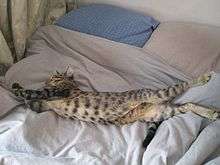
Bengal cats have "wild-looking" markings, such as large spots, stripes, rosettes, and a light/white belly, and a body structure reminiscent of the leopard cat.[3] A Bengal's rosetted spots occur only on the back and sides, with stripes elsewhere. The breed typically also features "mascara" (horizontal striping alongside the eyes), and foreleg striping. The eyes of a Bengal cat are relatively large and are usually bright blue or green.
The Bengal cat is usually either classed as brown-spotted or snow-spotted (although there are more colors,[13] brown and snow are the only colors of Bengal that the Governing Council of the Cat Fancy (UK) recognize). Within brown Bengals, there are either marble or spotted markings. Included in the spotted variation is rosetted, which consists of a spot with a dark line surrounding it. Snow Bengals are also either marble or spotted, but are also divided into blue-eyed or any other color eyes.
The International Cat Association recognizes several Bengal colors (brown, seal lynx point, mink, sepia, silver) and patterns (spotted and marbled) for competition and shows. In the New Traits class, other colours may be shown, as well as longhairs.[14]
Alongside other hybrid cat breeds such as the Savannah, Bengal cats are typically larger than the average house cat. Males on average weigh between 4.5–6.8 kg (10–15 lb) and females 3.6–5.4 kg (8–12 lb).[15]
Temperament
After three generations from the original crossing, the breed usually acquires a gentle domestic cat temperament;[3] however, for the typical pet owner, a Bengal cat kept as a pet should be at least four generations (F4) removed from the leopard cat. The so-called foundation cats from the first three filial generations of breeding (F1–F3) are usually reserved for breeding purposes (if female, as males of these generations are generally sterile) or the specialty pet home environment.[16] Bengals are known for liking water,[17] and require a large amount of attention to keep them happy. Bengals tend to be "talkative" and more vocal than other cat breeds. While they do meow similar to a typical house cat, they also make distinct chirping sounds.
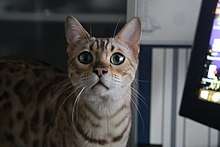
Bengals also enjoy playing, and have been recorded jumping over 4 feet from the ground. Bengals often imprint on their owner and become very attached; they do not like to be left alone for long periods of time.
Health
Bengal Progressive Retinal Atrophy (PRA-b)
Bengal cats are known to be affected by several genetic diseases. One of which is Bengal Progressive Retinal Atrophy, also known as Bengal PRA or PRA-b.
The test for this should be done by everyone breeding Bengal Cats as it is an inexpensive, noninvasive, and easy test to do. A breeder stating their cats were "vet tested" does not mean this test was done, as it is done by the breeder, outside of a vet office (rarely if ever by a vet), and sent directly to the lab. Labs that can perform the test include, UCDavis in the US and Langford in the UK.
"The disease causes the destruction of the cells that register light (photoreceptors) in the back of the eye (the retina). The loss of the cells begins around 7 weeks of age and slowly progresses until the cat has very compromised vision by approximately 2 years of age1. However, blindness develops at different rates in different cats. We have examples of cats over 2 years of age chasing a laser pointer; however vision testing by an ophthalmologist indicated that the cats should be blind. Blind cats tend to have more difficulty at night, sometimes becoming more vocal and more attached to their owners. The pupils are usually more dilated for affected cats than for cats with normal vision in the same lighting conditions. Affected cats also tend to carry their whiskers in a more forward position. Once affected cats know their surroundings, they are very mobile and active." [18]
Erythrocyte Pyruvate Kinase Deficiency (PK-Deficiency or PK-Def)
This is another of the common genetic diseases Bengal Cats can be affected by. This is another test that anyone breeding Bengal Cats should have done on their cats before breeding, as it is very inexpensive, noninvasive, and easy to do. This is never part of a normal "vet check" and if a breeder says their cats are "vet checked" it will not include this test. This is a test that a breeder must do on their own, and should always be able to show the documentation for it as it will always be at their fingertips as the results are emailed to them.
"Erythrocyte Pyruvate Kinase Deficiency (PK Deficiency) is an inherited hemolytic anemia caused by insufficient activity of this regulatory enzyme which results in instability and loss of red blood cells. The anemia is intermittent, the age of onset is variable and clinical signs are also variable. Symptoms of this anemia can include: severe lethargy, weakness, weight loss, jaundice, and abdominal enlargement. This condition is inherited as an autosomal recessive."[19]
Hypertrophic Cardiomyopathy (HCM)
"Hypertrophic Cardiomyopathy (HCM) is the most common heart disease of the cat. This disorder results in hypertrophy or thickening of the heart muscle which, in time, creates increased stiffness of the heart walls (muscle) causing poor cardiac function during the relaxation phase of the cardiac cycle (diastole). As this condition becomes worse, the thickened heart muscle can cause obstruction to blood flow leaving the heart via the aorta increasing the effort needed to pump blood out of the heart during the contraction phase of the cardiac cycle (systole)."[20]
HCM is a common genetic disease in Bengal Cats that has no genetic testing available at this current time (2018). The current practice of screening for HCM involves bringing cats to a Board Certified Veterinary Cardiologist and having an echo done to look at the heart and take measurements. It is said this should be done on a yearly basis for those cats being bred, so that the heart can be monitored. There is a lot of controversy over whether to screen for this disease or not, and it seems the breed has a very large divide, with about half of the breeders screening, and the other half not. This is due to a couple of major reasons.
Results Are Only Accurate For That Moment
HCM can occur at any point in time, including starting to develop the week after your annual or Biennial HCM screening.
Price and Distance
Screening Bengal Cats can demand a price of $150.00 to $600.00+ per cat and require a breeder to drive their cats sometimes 10 hours or more to have done, which causes undue stress on the cats. Additionally, cats should not be screened while pregnant or actively nursing and thus, breeders would need to make these trips several times a year for their cats.
The prevalence of hypertrophic cardiomyopathy is 16.7% (95% CI = 13.2–46.5%).[21]
Blood type
Most Bengal cats have type A blood according to a study held in the UK. Using RapidVet-H Feline blood typing cards (dms Laboratories), 98 of 100 Bengal cats tested positive for blood type A. The other two Bengal cats were retested and were found to be type A as well. This led to the conclusion that Bengal cats are predominantly Type A.[22]
Shedding and grooming
As well as being desired for their appearance, they are also known for being a breed that sheds very little. Many claim that the Bengal is a hypoallergenic breed, but this is purely anecdotal evidence, and while some people may not react, others will still have an allergic reaction to them. This has to do with the dander of the cat and not the amount that it sheds.[23]
Bengals are extremely efficient self-groomers, therefore they require little grooming. However, vets do recommend grooming once a week to limit shedding and keep their coat healthy.[24]
Long-haired variant
Some long-haired Bengals (more properly semi-long-haired) have occurred since the beginning of the Bengal breeding program,[25] as longer-haired domestic cats were among those used in crosses with the wild Asian leopard cat to produce the breed. Some current F4 and later purebred Bengals carry the recessive long-haired genes and when they are mated with each other, they can produce long-haired Bengals. (See Cat coat genetics#Genes involved in fur length and texture.) Such offspring were usually spayed or neutered until ongoing intentional development of the long-hair variety, as they did not then qualify as Bengal breeding stock due to their non-conforming long or semi-long coats. On August 21, 2013, long-haired Bengals were granted "preliminary" breed status in the New Zealand Cat Fancy registry under the breed name Cashmere, at the behest of a breeder named Damian Vaughan.[26][27] They are currently not recognized by any other cat registries.
Cheetoh crossbreed
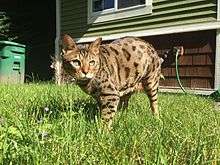
The Cheetoh cat is an ongoing program to crossbreed two existing breeds of spotted domestic cats with defined characteristics (the Bengal and the Ocicat), and develop the result into a third standardized breed that is distinct from both of the foundation breeds.[28] They were initially recognized by only a single minor and permissive breed registry, the United Feline Organization, starting in November 2004, but have been granted "experimental breed" status (not eligible for show competition) by a major registry, The International Cat Association, since at least May 2009, under the name Experimental Cheetoh, breed code XCT,[29] a status they still retain as of 2016.[30]
References
- ↑ "The International Cat Association: Bengal". Archived from the original on April 14, 2015. Retrieved April 9, 2015.
- ↑ Jones, Joyce. "The Pet Cat That Evokes the Leopard". Retrieved 13 August 2018.
- 1 2 3 4 Bengal Cat Animal World, Information Resource: Exotic Pets & Animals. Retrieved on: January 18, 2008
- ↑ "{title}". Archived from the original on 2018-02-04. Retrieved 2018-02-03.
- ↑ "Bengal Twins Kennel - Colors and patterns". www.bengalcat.hu. Retrieved 2017-02-04.
- ↑ Harrison William Weir, Our Cats and All About Them: Their Varieties, Habits, and Management, (Houghton, Mifflin & Co., 1889), p. 55.
- ↑ Cat Gossip, Periodical.
- 1 2 "A Brief History of the (Bengal) Universe". Bengal Classifieds. Retrieved 2009-10-25.
- ↑ Hartwell, Sarah. "Domestic x Asian Leopard Cat and Margay Hybrids". Messybeast. Retrieved November 13, 2015.
- ↑ "Willard Centerwall, MD". Loma Linda University Photo Archive. Retrieved 21 December 2017.
- ↑ "History of the Bengal Cat". Bengaland.com. Retrieved 2016-04-02.
- ↑ "The Dangerous Wild Animals Act 1976 (Modification) Order 2007". Legislation.gov.uk. 2014-11-04. Retrieved 2016-04-02.
- ↑ "A Visual Guide to Bengal Cat Colors & Patterns". 6 January 2018.
- ↑ Alan Brown. "Bengal cats & kittens - The International Bengal Cat Society - TIBCS - exotic looks with spots, marbling and snow". Bengalcat.com. Retrieved 2013-09-12.
- ↑ "Bengal Cat Facts | Bengal Cat World". Bengalcatworld.com. Retrieved 2015-11-15.
- ↑ "Breeding the ALC with domestic cats". Bengalcat.co.uk. Retrieved 2013-09-12.
- ↑ "Distinct character of the Bengal cat". Bengalcat.co.uk. Retrieved 2016-04-02.
- ↑ Bengal Progressive Retinal Atrophy (PRA-b). (n.d). Retrieved from https://www.vgl.ucdavis.edu/services/cat/BengalPRA.php
- ↑ Erythrocyte Pyruvate Kinase Deficiency (PK Deficiency) in Felines. (n.d). Retrieved from https://www.vgl.ucdavis.edu/services/pkdeficiency.php
- ↑ Signs, Symptoms and Treatment of Hypertrophic Cardiomyopathy (HCM) in Cats. (n.d). Retrieved from http://www.uvsonline.com/hypertrophic-cardiomyopathy-hcm/
- ↑ "Myosin-Binding Protein C DNA Variants in Domestic Cats (A31P, A74T, R820W) and their Association with Hypertrophic Cardiomyopathy". Journal of Veterinary Internal Medicine. 27: 275–285. 2013-01-17. doi:10.1111/jvim.12031. PMC 3602388. Retrieved 2013-11-02.
- ↑ Danièlle A. Gunn-Moore (2011-01-01). "Feline Blood Transfusions: A Pinker Shade of Pale - 2011 Journal of Feline Medicine and Surgery". Journal of Feline Medicine and Surgery. Retrieved 2016-04-25.
- ↑ "Bengal Cats–Are They Hypoallergenic? | Bengal Cats – Bengals Illustrated". www.bengalsillustrated.com. Retrieved 2015-11-15.
- ↑ "Bengal Cat Breed Information". Vetstreet. Retrieved 2015-11-15.
- ↑ Potter, Cathy (2006). ""Cashmere"—The Longhair Bengal". Grand Rapids, Michigan: AuroraLights Bengals. Archived from the original on 2013-09-27. Retrieved 2013-09-17.
We (Longhair breeders as a group) decided on the name 'Cashmere' due to the fact that the Longhairs have such an amazingly soft and silky coat. The Longhairs were not developed intentionally, but instead have occurred since the beginning of the Bengal breeding programs.
- ↑ "Minutes of Executive Council Meeting, August 2013". New Zealand Cat Fancy. Retrieved 22 December 2013.
- ↑ "Agenda for Executive Council Meeting, August 2013" (PDF). New Zealand Cat Fancy. Retrieved 22 December 2013.
- ↑ Domestication by Clive Roots, p. 114, Greenwood Publishing Group, 2007. Books.google.com. Retrieved 2013-09-12.
- ↑ "Standing Rules, 2009 Version A" (PDF). TICA.org. The International Cat Association. May 1, 2009. p. 53, §701.4.5. Archived from the original (PDF) on July 31, 2009. Retrieved August 16, 2016.
- ↑ "Standing Rules, 2016 Version A" (PDF). TICA.org. The International Cat Association. April 11, 2016. p. 54, §701.4.5. Archived (PDF) from the original on June 18, 2016. Retrieved August 16, 2016.
External links
| Wikimedia Commons has media related to: |